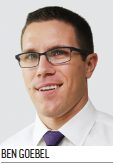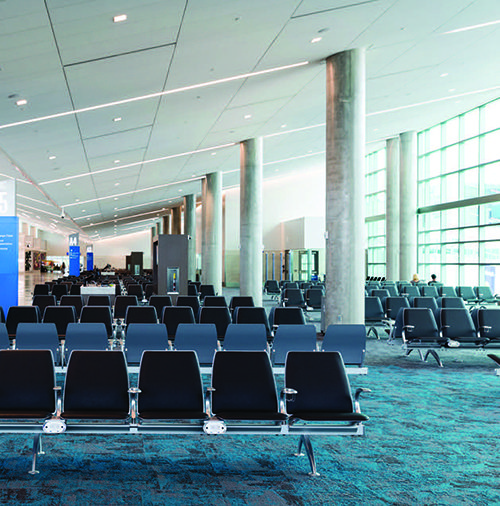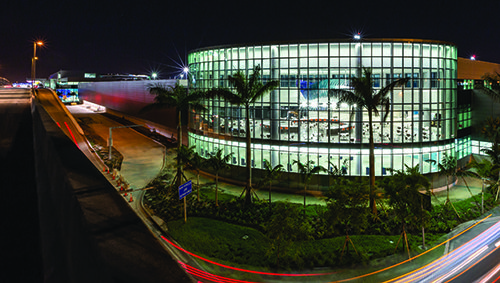Fort Lauderdale-Hollywood International Airport (FLL) recently completed a $333 million renovation of Terminal 1 to improve the experience for travelers and offer more operational capacity and flexibility.
Fort Lauderdale-Hollywood International Airport (FLL) recently completed a $333 million renovation of Terminal 1 to improve the experience for travelers and offer more operational capacity and flexibility. The program, which includes the addition of a new concourse and five swing gates, was part of a larger $3.2 billion capital program that is modernizing nearly every inch of all four terminals at the southern Florida airport.

In 2017, FLL served 32.5 million passengers, an 11% increase over the previous year. As owner/operator of the airport, Broward County Aviation Department worked to meet the growing traffic numbers and found success partnering with Southwest Airlines to deliver these most recent projects. Adding swing gates to accommodate more international and domestic service was of great interest to Southwest, notes Mark Gale, chief executive officer and director of aviation for the county department.
“The facilities that were in place had served us well for an airport doing 7 million to 9 million enplanements,” Gale explains. “But when we started to get up around 16 million-plus enplanements, the facilities were just insufficient to handle that type of traffic.”
|
Project: Terminal Renovation/Concourse Construction Location: Fort Lauderdale-Hollywood (FL) Int’l Airport Owner/Operator: Broward County Aviation Department Project Partner: Southwest Airlines Cost: $333 million Funding: Airport revenue bonds Key Components: 5 swing gates; new International Arrivals Facility; 12-lane consolidated security checkpoint; 80,000-sq.-ft. airside concessions court; new & renovated restrooms Timeline: Initial planning for Concourse A began in 2005, but was tabled until 2013; construction started March 2016; facility opened July 2017; B/C connector opened Jan. 2018 Construction Manager at Risk: Hunt Moss Joint Venture Program Manager: Parsons Prime Consultant & Concourse A Architect: Corgan Terminal 1 Renovation Architect, Signage & Wayfinding Designer, Structural Engineer: Gresham, Smith & Partners Retail Concessionaire: Hudson Group Food & Beverage Concessionaire: HMSHost Access Control: dormakaba Inbound Baggage Handling Systems: G&S Airport Conveyor Recheck Input System for FIS & Other Baggage Support Equipment: G&S Airport Conveyor Seating: Arconas Printers: VidTroniX |
Constructed in 2002, Terminal 1 had numerous deficits because of its pre-9/11 design—an issue shared by many U.S. airports. Many concessions were located pre-security, so amenities were limited once travelers were through the TSA checkpoint. In addition, all of its facilities, from restrooms to security checkpoints to holdrooms, were overloaded due to increasing passenger volume. The recently completed renovation/addition program not only modernized all of Terminal 1, but also allocated space to where it was needed, explains Chief Development Officer Marc Gambrill.
Planning for the Concourse A addition originally began around 2005, but was soon put on hold. In 2011, modernizing terminals 1, 2 and 3 took center stage, and airport leadership met with Southwest Airlines to discuss the carrier’s desire to grow its domestic and international operations and how FLL could fit into that strategic plan. Aviation department officials subsequently revisited the plan to add Concourse A and merged it with the Terminal 1 modernization in 2013. Because of the airport layout, the Concourse A and Terminal 1 projects were interdependent, explains Gambrill. “You couldn’t do each project separately,” he says, noting that it also made sense to partner with Southwest.
In late 2013, the airport board approved an agreement to have Southwest lead the project. The airline was responsible for administering and overseeing the modernization of Terminal 1 and the addition of Concourse A. “Working with the airlines, we’ve realized the benefits on both sides,” Gambrill says.
Although the agreement calls for a completion date of November 2019, Southwest and its project partners managed to close out the program in the fall 2018. Corgan and Gresham, Smith and Partners worked together to deliver the project as quickly as possible, explains Ben Goebel, principal and senior architect at GS&P. Corgan served as prime for the entire project and led the design of Concourse A; GS&P was a subconsultant and lead architect for Terminal 1.
Under the agreement with Southwest, everything from design through construction was approved by the airport and coordinated with operations, maintenance, concessions and other airline partners. “It’s not just allowing the airlines to do it; it’s a back and forth in terms of developing the program and coordinating it,” Gambrill states. “We’re very involved throughout the process, from procuring it and building it.”
Having Southwest take the lead on the capital project leveraged financial and logistic efficiencies, he explains. “No one knows their flight schedules better than they do.”
“We had a real need,” explains Randy Gillespie, director of airport affairs for Southwest. “It wasn’t just a need for a terminal, but a need for a terminal by a date certain. We absolutely had to finish building the facility where tickets were already being sold.”
Adding Capacity
Fully $200 million of the overall $333 million renovation program was invested in building Concourse A, a 330,000-square-foot, dual-level, greenfield construction with five swing gates. The new gates allow FLL to maximize utilization by handling domestic and international flights with the same facilities. In addition to Southwest, other airlines also utilize international capabilities on the new Concourse A.
Gambrill notes that the first step in working with Southwest was developing a project definition manual that identified design phases for the scope of work and coordinated all aspects with various stakeholders. Key constituents included the program management team, construction manager at risk team, U.S. Customs and Border Protection and TSA.

A new Federal Inspection Station—something Gale says was “desperately needed” for FLL to continue to grow internationally—was constructed in Concourse A. The new facility is designed to process 800 passengers per hour.
Corgan worked closely with CBP to design the new inspection station to meet current and future needs, says Bob Emery, associate principal at Corgan. Rather than the traditional two-step process for immigration, FLL’s new facility uses a newer one-step process. Immigration and Customs processing occur at the same point by the same officers after passengers have used an automated passport control counter or mobile passport control and claimed their baggage. “It’s much more efficient for CBP,” he remarks.
Terminal 1 Highlights
The design team employed strategic methods to make Terminal 1 feel larger. Changing light fixtures and removing display monitors and other heavy elements that made the space feel condensed helped open up the holdrooms visually, Goebel says.

“Even the simple thing of replacing the aged and dull T1 holdroom ceilings with a clean, white ceiling made the space feel taller,” adds Brad Sucher, an architect with GS&P.
Designers also added more natural lighting and used consistent finish materials to modernize the look and feel of Terminal 1. The color palette includes beach tones and coastal South Florida colors. “The space is more open, lighter, airy and more relaxing,” Goebel notes. New terrazzo flooring and a vibrant public art program add to the modern design of the facility.
A 40-foot-tall glass curtainwall (see photo on cover) provides an expansive view from the terminal entrance to the airfield. Providing a clear view from ticketing through concessions out to the airfield leads to intuitive wayfinding, and also helps travelers feel more comfortable and relaxed, says Sucher.
 Signage and wayfinding were updated and standardized—a project that will eventually cover the entire airport campus, notes David Park, senior environmental graphics designer with GS&P. “It’s a very clean, uniform, updated look,” he comments. “This gives the customer a lot more confidence in wayfinding.”
Signage and wayfinding were updated and standardized—a project that will eventually cover the entire airport campus, notes David Park, senior environmental graphics designer with GS&P. “It’s a very clean, uniform, updated look,” he comments. “This gives the customer a lot more confidence in wayfinding.”

Designers also used subtle architectural elements such as flooring, ceiling elements and interior lighting to help pull travelers’ eyes and guide them through the terminal. Using consistent finish materials for specific areas provides a similar influence, Goebel adds. For instance, vertical circulation structures all incorporate the same materials, and all restrooms have a unified color format. “When you walk down a corridor and see a sea blue wall, you intuitively know that’s a restroom,” he explains.
A 3,120-square-foot interactive play area and three service animal relief areas were also incorporated into the project.

Streamlining Security
Central to the modernization of Terminal 1 is the consolidation of two security checkpoints into one. Previously, each checkpoint had five lanes; the new consolidated checkpoint has a total of 12. It also has a secure corridor behind the ticket counters that connects concourses A, B and C.
The previous Concourse B security checkpoint was a serious problem, notes Gillespie. Its pre-9/11 design was inefficient at meeting post-9/11 security requirements and serving growing traffic numbers. Queues of waiting passengers often extended outside the terminal.
The new centralized checkpoint improves the process for passengers and TSA alike, Gambrill notes. The updated design allows the agency to make the most efficient use of personnel and equipment.
Design and process improvements have transformed the Terminal 1 checkpoint from what Gillespie considered to be one of the worst in the country to one of the best. “You can check more passengers in, you can get them on the other side of the security checkpoint and they have access to far more concessions,” he explains.
Access to Amenities
Thanks to the new centralized checkpoint, travelers passing through Terminal 1 now have access to concourses A, B and C—and all their respective amenities. Gale considers this a real “game changer” because it creates more revenue opportunities for FLL and its tenants.
Previously, passengers flying out of concourses B or C were limited to the concessions there after passing through security screening. In the new Terminal 1 environment, passengers now have access to all the options throughout concourses A, B and C. “The consolidated checkpoint plays a very key role in that,” Gale says.
Also, from an airport operations perspective, airlines now have the ability to use the facilities in the other concourses, allowing greater efficiency of gate resources.
With the addition of Concourse A, concessions square footage has doubled to approximately 56,000 square feet. The total number of retail locations increased from seven to 15; and on the food and beverage side, four new options bring the total to 18. “Like most airports, we strive to have a great mix of well-known, national brands, complemented with some local brands,” Gale notes.
New dining options from master concessionaire HMSHost include Jimmy Buffet Air Margaritaville Fort Lauderdale in the B/C connector; La Familia Tacos & Tequila in Concourse A; Landshark, Sergio’s and Torn Basil in Concourse B; and Shula Burger in Concourse C.
On the retail side, Hudson Group opened four stores within Concourse A in July 2017: Hudson, Tech on the Go, 5th & Sunset and CNN. In the B/C connector, travelers will find Hudson, 5th & Sunset, Sweet Indulgences, M•A•C, Rip Curl and Harley Davidson. Hudson also opened Intracoastal News in Concourse B and plans to open a Hudson, Desigual and Island of Bahama (beach/island-inspired apparel store) later this year.
“It transforms the guest experience,” Gale says of the new concessions offerings.
With greater concessions opportunities, revenue should grow, he reasons. In the first quarter of 2018 alone, passenger traffic in Terminal 1 increased about 16% compared to 2017, and food and beverage revenue was up about 20%. “We’re very encouraged by the numbers we’re seeing thus far,” Gale relates, “and we still have some locations that we can build out within the program as demand warrants.”
Working with all of FLL’s concessions partners (HMSHost and Hudson Group in terminals 1 and 2; Delaware North and Paradies Lagardere in terminals 3 and 4), Gale hopes to “take the overall concessions program to all new levels.”
“Square footage is finite and we want the highest and best yield out of our space,” he says. “But at the same time, we want to make sure we’re providing exactly what our guests are looking for when they traverse through our facility.”
Tailoring concessions and other amenities to the airport’s unique passenger profile was critical, Goebel says. For example, cruise passengers who start or end their trip at FLL often have eight-or nine-hour dwell times, so it was important to incorporate comfortable seating, power stations and other conveniences. The elliptical-shaped seating area in Concourse A is 7,330 square feet, with 200 seats, electronic charging stations and free Wi-Fi.

Resourceful Solutions
Due to FLL’s constrained footprint of only 1,400 acres, strategies to meet growing demand need to be creative. “We’re creating space on top of space,” Gambrill relates. “That’s a very unique component of this project.” The 80,000 square feet that was added to Terminal 1 was built on top of the existing structure, allowing for the addition of new concessions, a centralized checkpoint and connector facility. Moreover, the work was completed while 30,000 passengers traveled through Terminal 1 on a daily basis.

With such a complicated project, the construction manager at risk delivery methodology was particularly beneficial because of the close collaboration between parties, Gambrill explains. “You’re getting a contractor and designer on board; and as they’re designing it, you’re working with the contractor and designer to make sure that whatever they’re designing is constructible, and then also working on the construction phasing.”
Construction started in March 2016, and Concourse A opened for flights in July 2017; the B/C connector opened in January 2018. “If you look at this timeframe, the procurement method lends itself to getting a very complex project done in a tight timeframe,” Gambrill notes.
Phasing for the fast-paced, multi-project renovation program was an “extensive effort,” but having a construction manager helped smooth the process, says Sucher. “We have an 80,000-square-foot facility that was built on top of an active baggage handling system, next to gates that were constantly having carriers coming in and out, while blowing a hole through the ticket lobby and relocating two checkpoints without a hiccup to passengers,” he marvels.
Using building information modeling was critical to phasing the construction, Gambrill adds. The 3-D modeling allowed all project partners to work together to ensure constructability of the design, while also maintaining airport operations, he explains.
Prior to most of the construction, crews completed underground utility work and placed piles for Concourse A.
To increase security and decrease personnel costs, FLL incorporated a dormakaba Exit Lane Breach Control System into the modernization project. The one-way exit corridor guides the flow of arriving passengers to the secure side of the airport without the need for TSA personnel. Once a traveler exits, a set of doors closes behind him/her to prevent re-entry.
 Successful planning and coordination were demonstrated when crews placed giant exhaust fans on the roof of the connector facility between concourses B and C, reports Richard Welch, construction project manager for the Broward County Aviation Department. Initially, the team planned to use a crane for the task, but that would have taken up to a full week and would have caused operational issues. Instead, a helicopter was used to place the seven large exhaust fans. While more expensive, this solution was much more efficient and only took a couple of hours, explains Welch.
Successful planning and coordination were demonstrated when crews placed giant exhaust fans on the roof of the connector facility between concourses B and C, reports Richard Welch, construction project manager for the Broward County Aviation Department. Initially, the team planned to use a crane for the task, but that would have taken up to a full week and would have caused operational issues. Instead, a helicopter was used to place the seven large exhaust fans. While more expensive, this solution was much more efficient and only took a couple of hours, explains Welch.
“That’s a good example that it takes a team effort on all sides to accomplish a project like this,” Gambrill adds.
The team encountered an early challenge during the construction of Concourse A when floodplain maps for the area were revised, which raised the concourse level by approximately 2 feet above the existing Concourse B. To address this, designers stretched out the incline within the facility through a transition corridor between the two concourses.
Sustainability was also important on the project, Gambrill adds, and the new design includes low-water flow restroom fixtures, recycled building materials and ample natural light.

Future Outlook
Southwest’s growth at FLL has continued since the opening of Concourse A in summer 2017. Currently, the airline has 15 international flights and about 68 domestic. “We continue to see an appetite for international activity in the future,” says Gillespie, noting that such growth would not have been possible without the addition of Concourse A, its swing gates and the new federal inspection station.
FLL is making a habit of engaging its airline partners in construction projects. In addition to the arrangement with Southwest for Terminal 1, the airport has an agreement with Delta Air Lines to lead a $220 million program at Terminal 2 and another with JetBlue for Terminal 3. “We have a good track record of partnering with our airlines in order to enact major infrastructure development and complete programs here,” Gale notes. Each of the programs has different contract arrangements and delivery methodologies, but all must be approved by the Broward County Board of Commissioners in terms of budget, schedule and responsibilities.
Historically, FLL has been known as a low-cost alternative to Miami International Airport, its large hub neighbor to the south. But that seems to be changing, given the growth in flight volume and destinations served that FLL has experienced in recent years. “We believe we’re an airport of choice,” Gale remarks.
As passenger numbers track “well ahead” of forecasts, the airport continues to work with its airline partners to meet facility and passenger demands. “We’ve already begin to identify/plan for and fund additional improvements that will occur even before the Master Plan,” Gale reports, adding that the Terminal 1 project is “one piece of a larger puzzle.”
A $130 million program, expected to be complete within the next three years, calls for the construction of connector facilities to unite the entire airport campus so passengers can avail themselves of all FLL amenities after clearing a TSA checkpoint.
Terminals 3 and 4 are already connected post-security, and adding the “missing links” between the remaining terminals is something that Gale says will allow passengers to enjoy all the amenities FLL has to offer, and also give the airlines and other tenants the ability to manage the facility in a “much different and more efficient way.”
“This is just the tip of the iceberg,” he reflects. “We have so much more that we’re going to be able to produce as an airport when we get those other terminals connected behind security and start to effect the vision of the Master Plan.”
|
Canopy Project Kicks off Improvements Before Fort Lauderdale-Hollywood International (FLL) began heavy-duty renovations in Terminal 1, it replaced the exterior canopies that shield passengers from wind, rain and sun as they move between the airport’s four terminals. Construction on the $6.85 million project began in May 2014 and was substantially complete in September 2015. The new canopies were a good launching point that created positive momentum for the long schedule of improvements still to come, explains Wilson P. Rayfield Jr., executive vice president with project design consultant Gresham, Smith and Partners. “It signified to passengers that the airport was being modernized, and was a quick win,” he explains. “To have something that is noticeable at the front door come off successfully, quickly and early—I think there’s a lot of value to that.” During the project, crews removed the existing canopy supports between terminals 1 and 2, terminals 2 and 3, and terminals 3 and 4; built new steel structures in the same areas; and constructed a 150-foot extension on the Terminal 1 roof. To provide a robust system that would withstand the harsh conditions of South Florida weather, engineers designed a 12-foot tall steel structure that spans a total of 23 feet through two opposing 10-foot cantilevers. The steel structure is wrapped with 8-foot precast concrete panels to protect it in the high traffic area, and is white to provide a light and airy feel, with indirect illumination from the columns. Locating electric lighting at a relatively low elevation provides an even wash of light and makes it easy for maintenance crews to maintain, notes Rayfield. Because the new canopy system is a heavier structure than what was previously in place, FLL had to reinforce the roadway in some places to support the new concrete columns. |


 facts&figures
facts&figures


